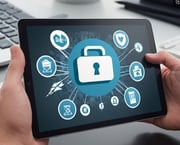
No matter what type of business you’re in, there’s a chance you’re dealing with sensitive information. From customer credit card details to patient diagnoses, the nature of the information you handle can vary. Regardless of its nature, you have a duty to keep your data safe. If you’re not yet using multi-factor authentication, you’re about to learn why you should start.
What is multi-factor authentication?
If you use online banking, there’s a chance you’re already familiar with multi-factor authentication. When you log into your bank account, you may need to enter two characters from your passcode and your password in its entirety. By that point, you’ve used two-factor authentication.
Multi-factor authentication takes another security step. For example, if it doesn’t recognize the device you’re using, it may ask you to confirm all the digits on your credit card. Or, if it does recognize the device, that automatic recognition is the additional step.
Multi-factor authentication makes BYOD safer
Around 59% of organizations use Bring Your Own Device (BYOD) policies. By allowing employees to use their own devices, you reduce your overheads. Additionally, you make it easier for them to work away from the office.
Although BYOD comes with the benefit of flexibility, each new device introduces security risks to your business. Multi-factor authentication that relies on device recognition could overcome this problem. By only allowing recognized devices to gain access to your work systems, you reduce the likelihood of cybercriminals using their devices to break into your network.
Using the cloud becomes simpler
Another technological advance that makes day-to-day business operations more flexible is the cloud. When you use the cloud, you can access information from anywhere. Additionally, it’s always available to you, even in the event of a disaster that destroys your hardware systems. In 2018, cloud usage reached 96%.
As the cloud can be accessed from anywhere, those who want to breach your security barriers can do so from anywhere too. If the cloud holds confidential information, failing to protect it properly could mean you’re not compliant with data protection legislation.
One popular multi-factor authentication tool that can overcome this is SMS push notifications. After a user enters their two-factor authentication details, they’ll receive a push notification to a phone that’s associated with their account. They then have a limited amount of time to enter the code they receive.
As push notifications only reach authorized phones, you significantly reduce the likelihood of a cybercriminal gaining access to your cloud’s data. This should provide peace of mind to you and your customers.
Maintaining compliance is easier
One of the biggest motivating factors for adopting MFA is maintaining compliance. Data protection regulations are changing all the time. From HIPAA in the healthcare industry to GDPR in Europe, whether your business exists solely in the United States or operates abroad too, there are rules you must follow.
MFA is a rigid and reliable way of protecting data. Depending on the type you use, it ensures you’re compliant with the laws that govern data protection in your industry. Although you can’t realistically guarantee that you’ll never lose someone’s data, you must try your hardest not to. By taking all available steps toward protecting data, you reduce the likelihood of facing hefty fines.
From safe cloud usage to data compliance, multi-factor authentication proves useful in lots of ways.
If you want to use it at your business, consult a team of professionals to find the best solution available.
Share this entry
-
Share on Facebook
Share on Facebook
-
Share on Twitter
Share on Twitter
- Share on Google+
-
Share on Pinterest
Share on Pinterest
- Share on Linkedin
- Share on Tumblr
- Share on Vk
- Share on Reddit
- Share by Mail
Subscribe to our Newsletter
Don’t miss out on the latest news from Entech. Submit your e-mail to subscribe to our monthly e-mail list.
.png?width=360&height=300&name=Logo%20(2).png)






-1.jpg?width=180&height=180&name=Image%20(8)-1.jpg)

